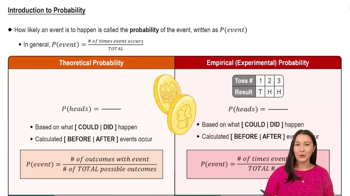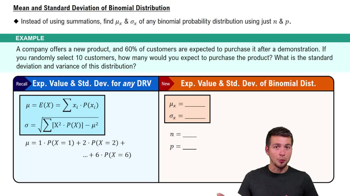Here are the essential concepts you must grasp in order to answer the question correctly.
Probability
Probability is a measure of the likelihood that an event will occur, expressed as a number between 0 and 1. A probability of 0 indicates an impossible event, while a probability of 1 indicates a certain event. In this context, understanding how to calculate the probability of specific outcomes, such as tossing tails in a series of coin flips, is essential.
Recommended video:
Introduction to Probability
Binomial Distribution
The binomial distribution is a probability distribution that describes the number of successes in a fixed number of independent Bernoulli trials, each with the same probability of success. In the case of tossing a coin, it helps determine the probability of getting a certain number of tails (successes) in a set number of tosses. This concept is crucial for solving the problem of tossing tails exactly half the time in four tosses.
Recommended video:
Mean & Standard Deviation of Binomial Distribution
Combinatorics
Combinatorics is a branch of mathematics dealing with combinations and permutations of objects. In probability problems involving multiple trials, such as coin tosses, combinatorial methods are used to calculate the number of ways a specific outcome can occur. For example, determining how many ways you can get two tails in four tosses is essential for finding the corresponding probability.





